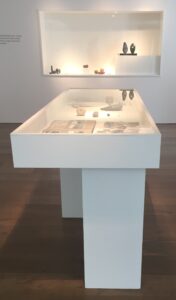
I was recently asked to review a rather interesting exhibition. The review has now been published in The Orcadian and I have their permission, and that of The Pier Arts Centre who commissioned it, to publish it here.
Any exhibition bears a similarity to an onion – it is many layered. Not only will it be viewed by people of different backgrounds, each of whom takes away a different experience, but, in addition, a range of separate meanings is, inevitably, built in by the creators and their objects. Consider then, the fate of the hapless reviewer when confronted by an exhibition that not only presents several collections of material in interesting juxtapositions but also does so in separate locations. Such is my lot.
Conversations With Magic Stones takes place in three locations: The Orkney Museum; The Pier Arts Centre; and Stromness Museum. It makes use of four categories of material: contemporary art; modern/classical art; Orkney archaeology; ethnographic pieces.
The largest display occurs in the Orkney Museum where we are treated to a spectacular collection of ancient stone tools from Orkney. They range from as much as 12,000 years old to around 3000 years old, some are piled high, others neatly set out in isolation, a few nestle in the tins and boxes where they have rested since their discovery in years gone by. Alongside them, on the walls and in the cases, are works of art that draw on their inspiration. A shiny ‘carved stone ball’ of bronze by Babette Bartelmass plays with the idea of material as immutable, as do flint axes of glass and metal by Paul Musgrove. The latter’s prints, which layer images of the artefacts under site plans, notes and old labeling, create a new view of the past, as seen through the obscuring discolourations of time. Wall panels provide an encyclopaedic background of information. Through these we learn of the collectors who amassed many of the pieces on display.
In the Pier Art Centre, we are taken in to the studio, and mind, of Barbara Hepworth whose comments about ancient stone tools prompted the title and thrust of the work. Seeing her sculptures in juxtaposition with a selection of Orkney artefacts is chilling. It is a none too subtle reminder that for everything, even the most perfect art displayed in isolation on a carefully designed pedestal, there is a backstory and a context.
After the archaeological staginess of the Orkney Museum and the clarity and light of the Pier Art Centre, the Stromness Museum comes as something of a shock. The cases here are deliberately busy, the objects weird and wonderful, and the stories exotic. Here we learn of the pieces that found their way to Orkney from overseas, of the roles they played in their homelands and of the meanings they brought to Orkney. It is an evocative reminder of the way in which our roots help to shape the people we become and one cannot help wondering about the connections made between the worlds of past and present.
Overall, the exhibition creates some powerful impressions. The focus on the work of collectors, early excavators, and artists, invites us to enter a state of intellectual curiosity. We meet the people who sought to make sense of the relics of the past that were coming out of the ground across Orkney. People who cared passionately about the objects they were finding, and who handed this interest down to their descendants many of whom still treasure the pieces. With the objects come stories and a wonderful by-product of the work has been to enshrine these memories for the future, to prolong the life of the objects from their prehistoric origins into the twenty-first century and to lift them from fodder for archaeology into more complex beings – as the catalogue says: ‘an afterlife of things’.
It is an exhibition that, generally, eschews the principals of archaeological display. Photos lack scales, pieces lack provenance. This can be annoying for the academic viewer but it does avoid clutter and transforms the general atmosphere into that of an art exhibition. In reality, there is a catalogue and the Orkney museum does provide a handy computer to access data such as location, date and context through the project website. The feeling of having strayed from archaeology into art is emphasised by the wonderful photographs. It is a rare photographer indeed who can provide close up images of tooling or texture that will allow enlargement fit for a wall panel. In the Pier Art Centre this theme is pushed further as conventional archaeological terms are dropped and the artefacts become part of the artist’s studio.
Staying with the Pier, there is, perhaps unconsciously, an element of hagiography in the way in which the only woman to really feature in the exhibition has this location devoted to her. There is, for this reviewer, a twinge of regret that the women who undoubtedly collected elsewhere in Scotland, were not apparently collecting in Orkney (too busy minding the farms perhaps?). Yet, whatever happened in the past, it is worth noting that the exhibition team are more equally divided: they should be congratulated for a challenging, thought provoking display.
You will find the project website here
And the artist’s catalogue here
You must be logged in to post a comment.